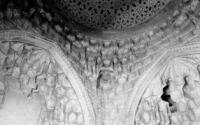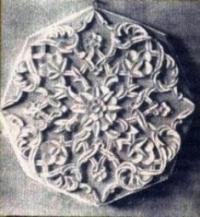Вы здесь
Palace of the Samanids.




History Uzbekistan and Central Asia.
“That was the day the ancient songs of blood and war spilled from a hole in the sky
And there was a long moment as we listened and fell silent in our grief and then one by one, we stood tall and came together and began to sing of life and love and all that is good and true
And I will never forget that day when the ancient songs died because there was no one in the world to sing them”
Brian Andreas.
Package tourists in Samarkand.
The palace of the Samanids (the IX – X c.c.) was revealed thanks to archaeological excavation at the western part of Afrasiab, between the third and fourth walls. General architecture of the palace remains unknown – just two halls with ganch panels and rich mihrab were discovered.
Stylistically and semantically affined decorative panels were found at the summer residence of Bukhara governors in Varakhsha (the VII - VIII c.c.). In the early Middle Ages, a governor was one of major figures in cultic rituals, what, probably, found reflection in a decor of palace halls.
Ganch decor at the Samanid palace represents total filling, or "charming", of the space with floral patterns. They are supplemented with familiar symbols of earth, water, sun and four-parted signs of Good spreading “to four sides”.
In the second hall, he ornaments base on various types of "running" swastika, a symbol of solar energy and fire. Compositions of these signs transmitted ideas of interrelating natural forces and were considered magically strong signs protecting from evil.
Essentially new property of Afrasiab panels is their complex geometrical structure and harmonic compositions, which reflected a new level of Islamic applied mathematics at the end of the VIII - X c.c.
In the first hall, carved ganch panels framed three doors and the lower part of walls. The compositions included round complicated signs, such as Buddhist "mandala", transmitting the universal order. In both halls, there are panels exposing eight-pointed stars within eight-petal "flower", "flower" escribed in a circle, a circle escribed in a square.
The symbol “square in circle” transmits the universal order and harmony of the Earth and Space in their eternal integrity. “Circle with flower inside a square” indicates to the Sun representing a source of Life on the Earth.
Besides that, eight-petal "flower" (lotus) usually symbolizes Yin with sacred object or its symbol in the center, often Yang sign. All this composition served ritual purposes - the deity gravitated to the center of "flower" and, going down from the heaven, performed some divine action bringing abundance and success.
In Afrasiab compositions, eight-pointed star might symbolize the stable and eternal Sun as universal source of energy. Another type of symbolic compositions contains six-petal "flowers" and six-pointed stars ("King David's" hexagram), which are escribed in a circle of pearls.
Traditional semantics of David’s hexagram is Yang-Yin interaction as a fundamental law of Life: a triangle with vertex upward - Yang (fire, sky), a triangle with vertex downward - Yin (water, earth). Circles from pearls symbolize human and universal Soul.
Very indicative is the carved mihrab, which has the most archaic symbol in the center– “Tree of Life”. Heathen sacral formulas in the palace decor witness that Samanid culture was not restricted just to Islam.
Probably, the Samanid policy of cultural independence from the Abbasid Caliphate required non-Muslim cultic symbols, traditional and familiar to the majority of population.
Authority:
Alexey Arapov. Samarkand. Masterpieces of Central Asia. Tashkent, Sanat. 2004.







